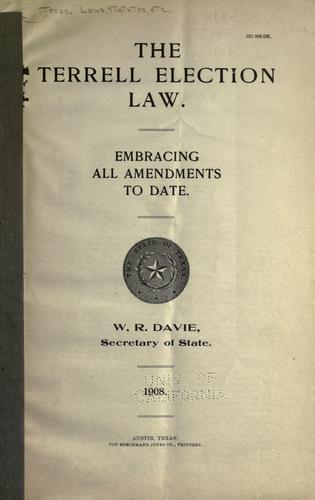Passed in 1905, the Terrell Law created a statewide direct-primary system for all state, district, and county elective offices in Texas. The provisions of Terrell legalized and encouraged the creation of “whites-only” primary election voting requirements that resulted in minority voter discrimination in Texas for the next four decades. Image from Open Library.
The Moment: On April 3, 1944, the U.S. Supreme Court overturned the Texas law that authorized political parties to set their own rules for voting requirements, including the practice of holding “whites-only” primary elections.
Why It Matters: The landmark ruling of Smith v. Allwright had far-reaching implications in Texas and other states that barred non-whites from voting in primary elections.
By 1944, voter discrimination in Texas should have long been a thing of the past, according to the U.S. Constitution.
The 14th Amendment, which granted citizenship, civil and legal rights to African Americans and former slaves, had been ratified in 1868—followed two years later by the ratification of the 15th Amendment, which prohibited denial of voting rights on the basis of race or color. In 1920, Congress ratified the 19th Amendment, which guaranteed voting rights for women.
But in mid-century Texas, voting equality existed only on paper. Despite the freedoms promised by these amendments, Texas and other states employed a number of tactics to disenfranchise minority and poor voters, including legalized oppression in the form of discriminatory election laws as well as unofficially-sanctioned voter intimidation practices.
One of the most effective means of discrimination was the “white primary”, which barred non-whites from joining the Democratic party (then the only major political party operating in Texas) or voting in Democratic primary elections. Although the state’s white primary law was struck down by two Supreme Court rulings (Nixon v. Herndon, 1927, and Nixon v. Condon, 1932), Texas engineered a workaround in the form of a law that allowed Texas political parties to set their own rules, including whites-only primaries. This law was upheld in a 1935 Supreme Court decision, Grovey v. Townsend.
Ramifications for Texas women…
In 1977, Texas civil rights leader Christia Adair recalled her first voting experience during an oral history interview with the Schlesinger Library at Radcliffe College.
The year was 1918, and Texas women had just won the right to vote in the state’s Democratic primary election. Christia, then in her early twenties, had worked to secure the law’s passage, as had many of her civic-minded friends. They readied themselves for the historic 1918 primary election with great anticipation.
“The white women were going to vote,” she said. “And we dressed up and went to vote, and when we got down there, well, we couldn’t vote. They gave us all different kinds of excuses why. So finally one woman, a Mrs. Simmons, said, ‘Are you saying that we can’t vote because we’re Negroes?’ And he said, ‘Yes, Negroes don’t vote in primary in Texas.’ So that just hurt our hearts real bad.” (Read more at Houston Public Media.)
Christia’s experience was mirrored at polling places in other locations in Texas, as minority women attempted to exercise voting rights that year and in many years subsequent to the ratification of the 19th Amendment. The incident proved an inspirational catalyst in the life of the young suffragist, who would later become one of the most noteworthy civil rights activists in Texas.
Smith v. Allwright…
In fact, Christia was serving as the executive secretary for the Houston branch of the NAACP when the chapter decided to mount a fourth challenge to the Texas white primary system, this time in the name of Dr. Lonnie E. Smith, a prominent Houston dentist who sued election official S. S. Allwright after Smith was denied a ballot in the 1940 Harris County primary.
Counsel for the NAACP, Thurgood Marshall (later the Court’s first African-American justice), argued that the Texas primary system violated the 14th and 15th Amendments, since the law allowed whites to dominate the politics of the (then) one-party South.
Marshall prevailed, and the Court struck down the Texas law in an 8-1 vote. In the opinion penned by Justice Stanley F. Reed, he noted: “The United States is a constitutional democracy. Its organic law grants to all citizens a right to participate in the choice of elected officials without restriction by any state because of race. This grant to the people of the opportunity for choice is not to be nullified by a state through casting its electoral process in a form which permits a private organization to practice racial discrimination in the election. Constitutional rights would be of little value if they could be thus indirectly denied.”
Impact…
In the wake of the Court’s ruling, African-American voter registration vastly improved in Texas and throughout the South, swelling to more than 700,000 registered voters in 1948 and to one million by 1952. In Texas, the number of African Americans registered to vote increased from 30,000 in 1940 to 100,000 in 1947.
From the NAACP Legal Defense and Educational Fund website: “The implications of Smith had far-reaching effects on race relations in the South. It was the watershed in the struggle for Black rights, and it signaled the beginning of the Second Reconstruction and the modern civil rights movement. The political and social advances of Blacks simply could not have occurred without the changes that came in the wake of the overthrow of the Democratic white primary.”
Additional Learning:
“The Battle for the Black Ballot” by Charles L. Zelden [University Press of Kansas]
“How Texas Prevented Black Women From Voting Decades After The 19th Amendment”
“Black Victory: The Rise and Fall of the White Primary in Texas” by Darlene Clark Hine [University of Missouri Press]

